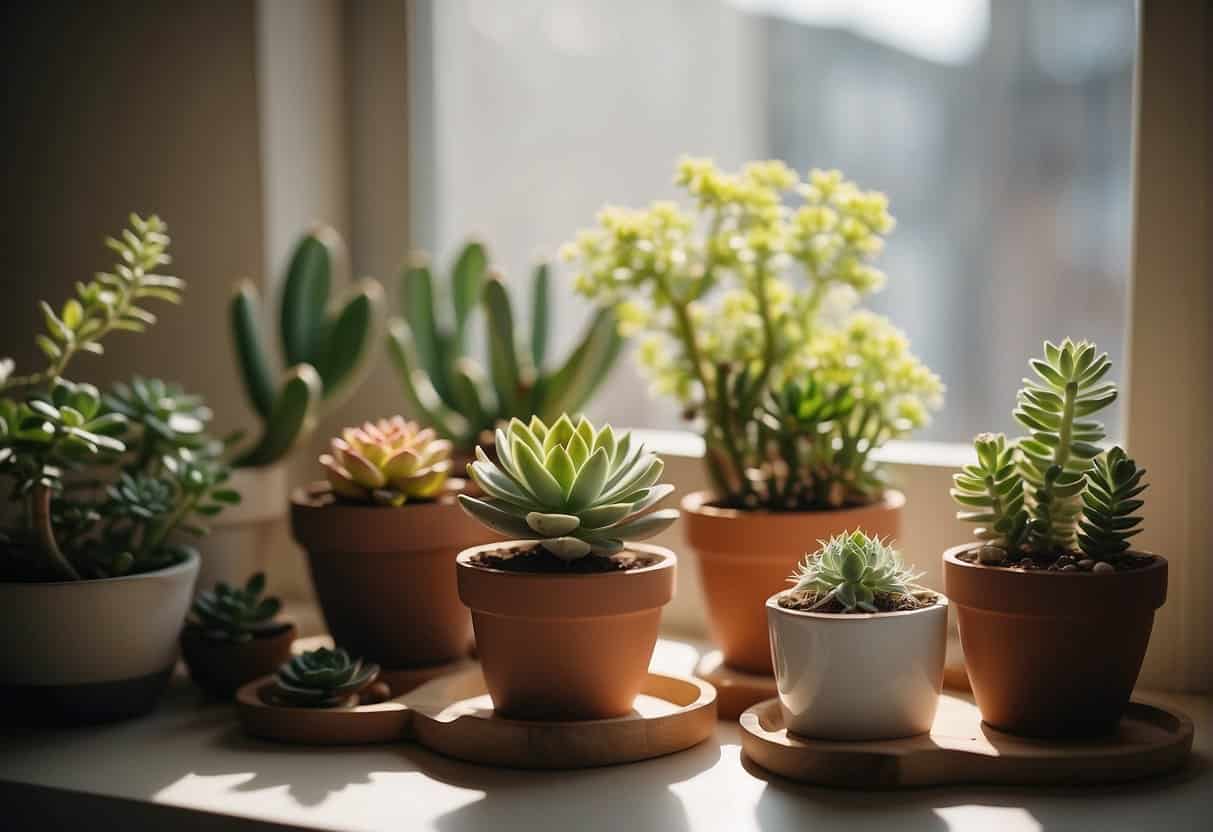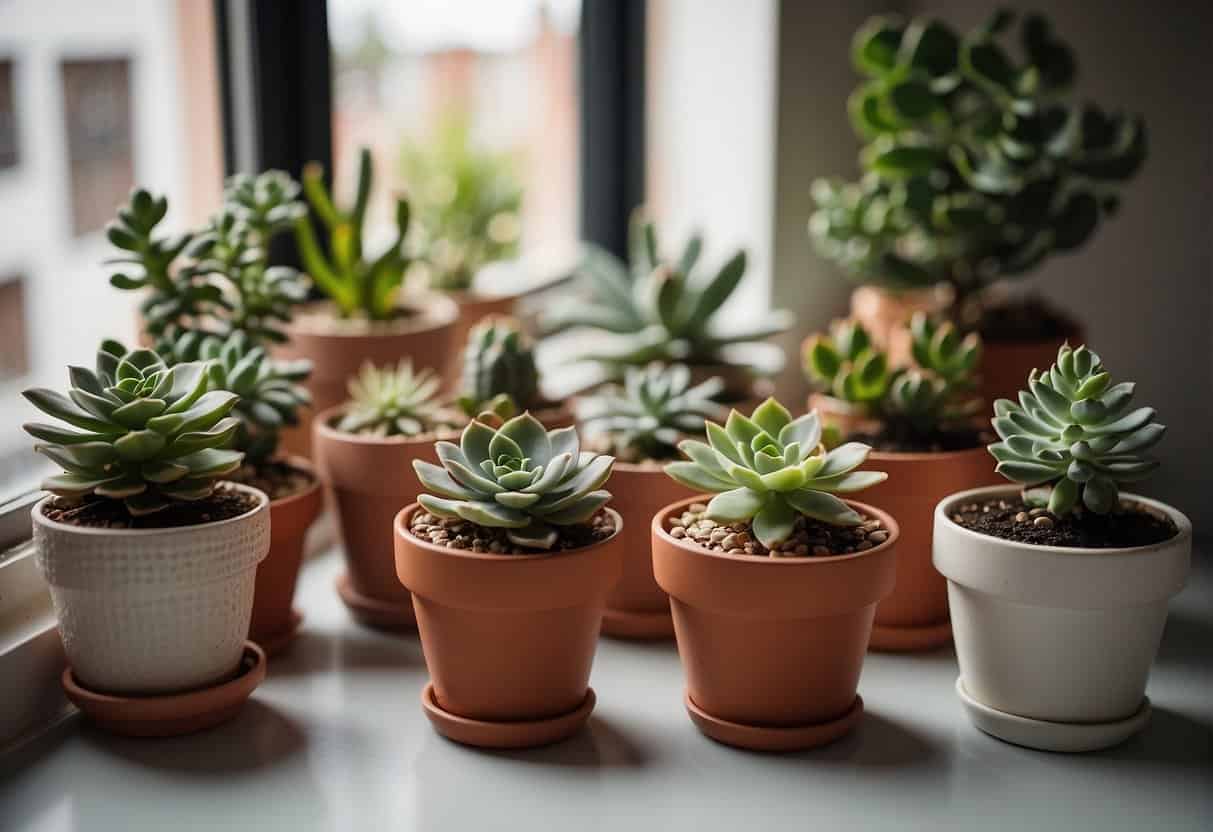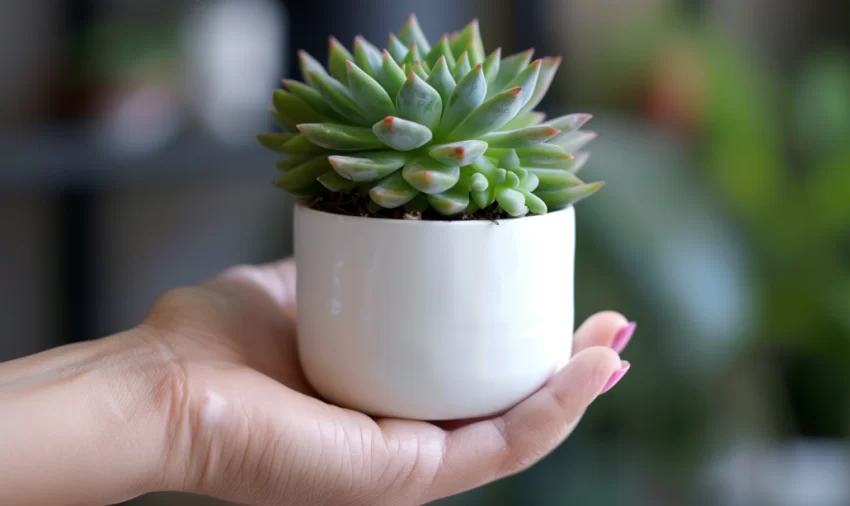Living in a small apartment doesn’t mean forgoing the joy of having greenery in your home. Potted succulents are ideal for small areas since they occupy very little room and add a refreshing touch of nature to any setting. These hardy plants are well-suited to indoor environments and thrive with minimal care, making them perfect for those who desire a bit of green without the hassle of rigorous maintenance.

Succulents come in an array of shapes, sizes, and colors, providing ample options for personalization and style. From the tiny but striking Aloe ‘Pepe’, known for its ability to stay under three inches tall, to the pebble-like appearance of Lithops, each plant can add a distinctive flair to an apartment. These plants are not just decorative; they are practical, requiring minimal water and thriving in a variety of light conditions, reinforcing their status as apartment-friendly choices.
Incorporating mini succulents into an apartment can be both a creative endeavor and a pragmatic approach to gardening in a small space. With their capacity to endure in bright indoor light and their proficiency in water storage, these plants are conducive to busy lifestyles. They offer an effortless splash of life to any space, proving that even the smallest apartments can house a quaint collection of greenery.
Selecting the Right Succulents
When choosing succulents for an apartment setting, it’s essential to consider their light requirements, size, and watering needs. The right selection can turn a small living space into a thriving green area that requires minimal maintenance.
Succulents for Low Light Conditions
Not all apartments are flooded with sunlight, but that doesn’t mean you can’t enjoy succulents. Low light conditions are suitable for the ZZ plant (Zamioculcas zamiifolia) and snake plant (Sansevieria). These succulents thrive in indirect light and can tolerate dimmer areas of your home.
- ZZ Plant: Prefers low, indirect light and infrequent watering.
- Snake Plant: Adaptable to low light; allows for some neglect in terms of watering.
Small Succulent Varieties for Tight Spaces
For residents with limited room, selecting compact succulents is key. Varieties like the jade plant (Crassula ovata) and aloe vera are ideal for tight spaces due to their small footprint.
- Jade Plant: Compact size; maintainable with proper container and regular pruning.
- Aloe Vera: A modest grower that fits well on window sills.
Succulents With Minimal Watering Needs
Those new to plant care or often away from home may prefer succulents with minimal watering requirements. The cactus family, including varieties like the Echeveria, Sedum, and certain species of Hawthoria, can go longer periods without water, making them a practical choice.
- Echeveria and Sedum: Require soaking and drying method; less frequent in colder months.
- Haworthia: Tolerates drought; water thoroughly when soil is completely dry.
Containers and soil are equally important for these succulents. Use pots with drainage holes and soil with good aeration to prevent overwatering, a common issue in indoor settings.
Creating the Ideal Environment in Your Apartment

Creating an ideal environment for potted succulents in an apartment setting revolves around optimizing light availability and ensuring suitable humidity and air circulation. Success in growing healthy indoor plants in small spaces is largely determined by how these elements are managed.
Managing Sunlight and Artificial Light
Succulents require a significant amount of light to thrive. Positioning them on a windowsill that receives ample sunlight during the day is ideal. However, supplementing with a grow light is an effective solution for apartments without sufficient natural light.
Use direct light for hardy species and indirect sunlight for more delicate plants to prevent leaf burn. It’s recommended that succulents receive at least five to six hours of light per day.
- Direct Sunlight: Place succulents that can tolerate direct exposure on south-facing windowsills for maximum sunlight.
- Indirect Sunlight: For plants that prefer indirect light, position them in areas where the light is diffused, such as near a sheer-covered window or farther back from a sun-lit area.
Understanding Humidity and Air Circulation
Succulents prefer a dry environment with low to moderate humidity levels. In an apartment setting, it’s important to regulate humidity and promote ventilation to mimic their natural habitat.
Dehumidifiers or opening windows to allow wind and air exchange can help manage moisture levels. Additionally, be cautious with plants like air plants, which can suffer in overly dry environments and may need occasional misting to maintain their health.
- Low Humidity: Maintain a comfortable level of humidity to avoid rot and diseases in succulents.
- Air Circulation: Ensure good air movement around your plants. Consider using a fan to provide gentle airflow and discourage pest infestation.
Caring for Your Apartment Succulents
Caring for succulents in apartments involves understanding the specific needs of these resilient plants, from watering techniques to the type of soil and fertilizers that promote healthy growth, to managing pests that may arise.
Watering Techniques for Apartment-Dwelling Plants
When watering succulents, adopting a “soak and dry” method is crucial. Water the plants thoroughly, allowing excess water to drain from the containers. Then, wait until the soil is completely dry before watering again.
Overwatering can be detrimental, so providing a consistent and appropriate watering schedule is key. For instance, watering smaller pots might be done weekly, while larger containers can hold moisture longer and may only require bi-weekly attention.
Soil and Fertilizer Recommendations
Succulents prefer a well-draining soil mix, which typically consists of potting soil combined with coarse sand or perlite to promote proper drainage. Adding organic matter can improve soil structure and provide nutrients.
While succulents are low-feeders, a balanced fertilizer can be incorporated sparingly during their growing season to support their needs.
Preventing and Treating Common Pests
Pests such as mealybugs and aphids can occasionally infest houseplants. Preventative measures include keeping the plants clean and inspecting them regularly for signs of pests.
In case of an infestation, one can apply isopropyl alcohol with a cotton swab directly to the pests or use an appropriate insecticidal soap. Maintaining good air circulation around succulents also discourages pest outbreaks.
Design And Display Ideas for Apartment Succulents

Decorating an apartment with succulents brings not only greenery but also a touch of nature’s calm to small spaces. Utilizing creative containers and vertical displays can maximize your use of space while showcasing these adaptable plants.
Creative Container and Planter Solutions
When space is at a premium, containers become the centerpiece of design for apartment plants. Innovative and space-saving options like magnetic planters that adhere to metal surfaces or a hanging basket that can be suspended from the ceiling not only save countertop space but also add an artistic flair to your living area.
For those with limited windowsills, a tiered planter offers multiple levels for succulents to bask in the sunlight, conserving precious surface area while keeping your greenery in sight.
Making the Most of Your Space with Vertical Gardens
Vertical gardens serve as living art, and for those residing in apartments, they are a smart solution to cultivate an array of succulents without sacrificing floor space.
A green wall, installed with modular planters, transforms any wall into a verdant focal point. Utilizing hanging baskets at different levels creates a cascading effect, adding depth and character to your decor.
Configuring a grid of shelves for your potted succulents enables you to curate a bespoke green display that conforms to the specific contours and styles of your apartment space.
Integrating Succulents with Other Apartment-Friendly Plants

In the confined space of an apartment, finding suitable plant companions for succulents can enhance the aesthetic appeal without overcrowding. When incorporating other plants, the drought-tolerant properties of succulents should be a key consideration alongside light and space requirements.
Ferns make a lush backdrop for the sculptural forms of succulents. They thrive in more humid conditions, but by placing them in a separate decorative pot, one can maintain unique moisture levels for each. Ferns also enjoy the shade, thereby not competing with succulents for sunlight.
A Spider Plant, with its arching leaves and easy-going nature, can be a great companion to potted succulents. The spider plant requires more frequent watering than succulents, but its resilience in various conditions allows it to be placed nearby without mutual interference. Their tendency to produce offshoots also means they can fill vertical space, creating a dynamic display.
Peace Lilies can add a touch of elegance with their signature white blooms. They enjoy medium to low light and higher humidity but can adapt to the dryness preferred by succulents when placed in a well-ventilated area. Regular monitoring will ensure harmony in their shared environment.
| Plant | Light Need | Watering Frequency | Benefits |
|---|---|---|---|
| Ferns | Indirect, low | High | Adds lush greenery and texture |
| Spider Plant | Bright, indirect | Moderate to high | Air purifying and easy to grow |
| Peace Lily | Low to medium | Moderate | Blooms add elegance; tolerates low light |
Advanced Tips for the Avid Apartment Gardener

Advanced strategies in apartment gardening can elevate the experience and variety of plants in small spaces. The following tips delve into expanding your garden beyond succulents and the intricacies of breeding and propagating these hearty plants.
Expanding Beyond Succulents: Diversified Indoor Gardening
While succulents are the cornerstone of easy-to-care-for apartment gardening, one may consider introducing other plant varieties like ferns and palms, which can thrive indoors with the right conditions.
Incorporating citrus trees can be an ambitious yet rewarding option. These trees require ample sunlight and careful watering, and they bring fresh scents and potential fruit harvests.
- Select ferns tailored for low-light apartments. Ensure they are kept in humid conditions and not in the path of direct sunlight.
- Palms can add height and tropical flair. Choose varieties like the Parlor Palm that are more tolerant of indoor conditions.
- Citrus trees, like dwarf lemons or limes, need bright light. South or west-facing windows are ideal. They benefit from regular misting to maintain humidity.
Breeding and Propagating Your Succulents
Advanced apartment gardeners can find joy in breeding and propagating their succulents.
- Breeding: You can cross-pollinate succulents during the bloom period to yield new variants. Utilize a brush to transfer pollen and tag crosses carefully to track results.
- Propagation: Increase your collection through cuttings. After clipping, allow the cut end to callous over before planting in soil. This prevents rot and encourages new root growth.
Propagation techniques:
- Leaf cuttings: Gently twist a leaf from your succulent, let it dry, then place it on top of soil until roots develop.
- Stem cuttings: Cut a healthy piece of stem, dry the end, then plant it in soil. Water sparingly until the cutting establishes.
Frequently Asked Questions

This section answers commonly asked questions to assist apartment dwellers in selecting and caring for succulents in confined spaces. It provides practical tips tailored for small living areas and specific needs.
How can I ensure low-light succulents thrive in darker areas of my apartment?
To help low-light succulents thrive, one should select species that are adapted to lower light conditions, such as Snake Plants or Zamioculcas zamiifolia (ZZ Plant), and place them in areas where they can receive indirect sunlight. Regular monitoring and a strict watering schedule are crucial to avoid overwatering.
What are some air-purifying succulents suitable for small apartments?
Aloe Vera and Spider Plants are known to purify air, making them great choices for small apartments. They are effective at removing common household toxins and require minimal maintenance, which fits well in a small-space lifestyle.
Which succulents are most recommended for beginners in apartment settings?
Beginners should look for succulents like Echeveria or Jade Plants, which are forgiving and adapt well to indoor conditions. They require minimal watering and can flourish with proper light and occasional fertilization.
What are the top succulent choices for households with cats?
For cat-friendly households, Haworthia and Blue Echeveria are non-toxic to pets. These succulents are safe and won’t harm curious cats while adding greenery to small spaces.
Can you list mini succulent varieties ideal for limited indoor space?
Mini succulent varieties ideal for limited space include Baby Toes and Lithops. These tiny plants take up little room yet offer unique textures and forms to enhance compact living areas.
Are there specific succulents that can survive well in humid bathroom environments?
Succulents like Orchid Cactus and Christmas Cactus are more tolerant of humid conditions. They can be successfully grown in bathroom environments where other succulents may not thrive as well.


